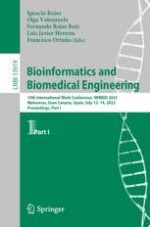2023 | Buch
Bioinformatics and Biomedical Engineering
10th International Work-Conference, IWBBIO 2023, Meloneras, Gran Canaria, Spain, July 12–14, 2023, Proceedings, Part I
herausgegeben von: Ignacio Rojas, Olga Valenzuela, Fernando Rojas Ruiz, Luis Javier Herrera, Francisco Ortuño
Verlag: Springer Nature Switzerland
Buchreihe : Lecture Notes in Computer Science
